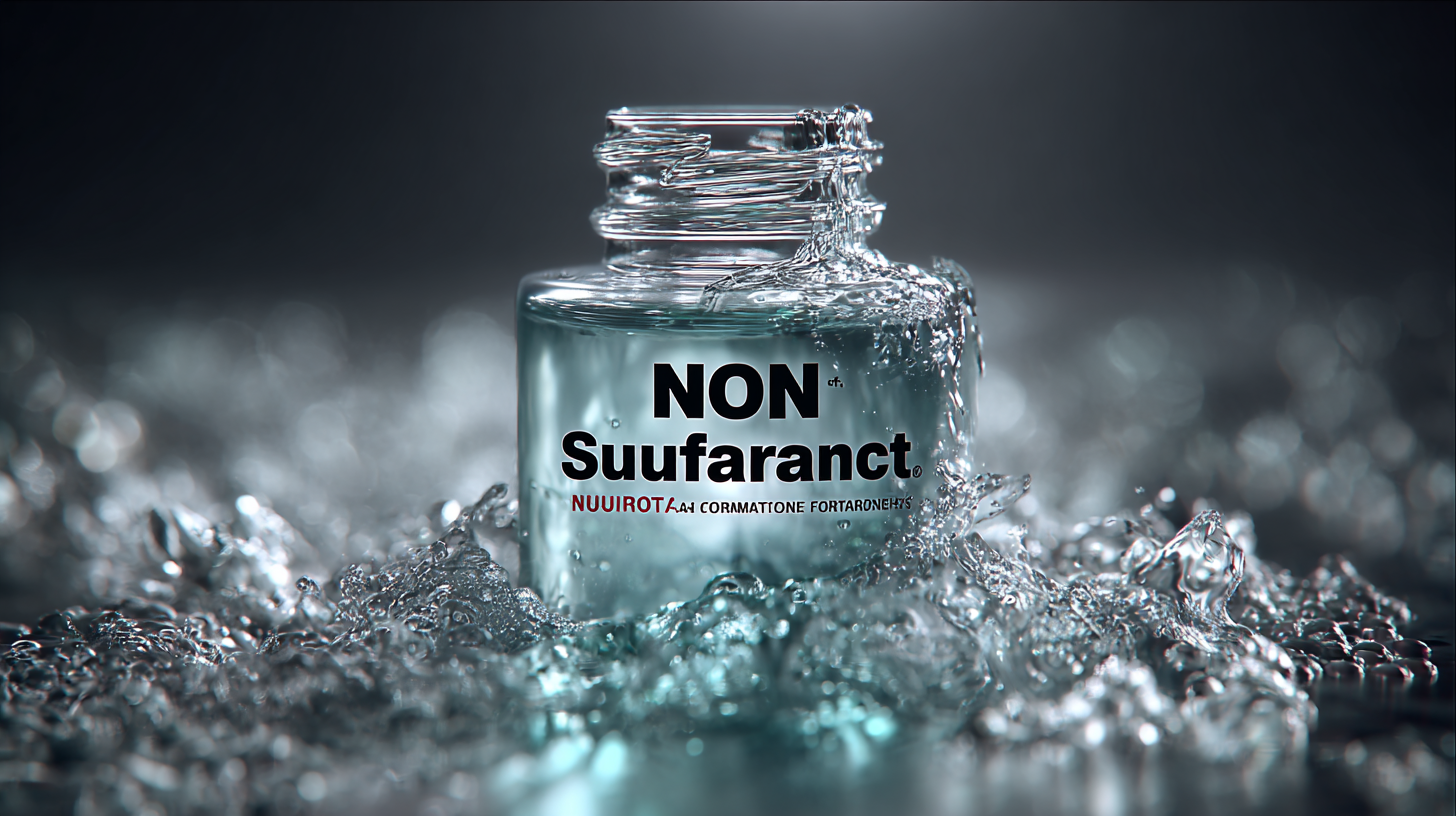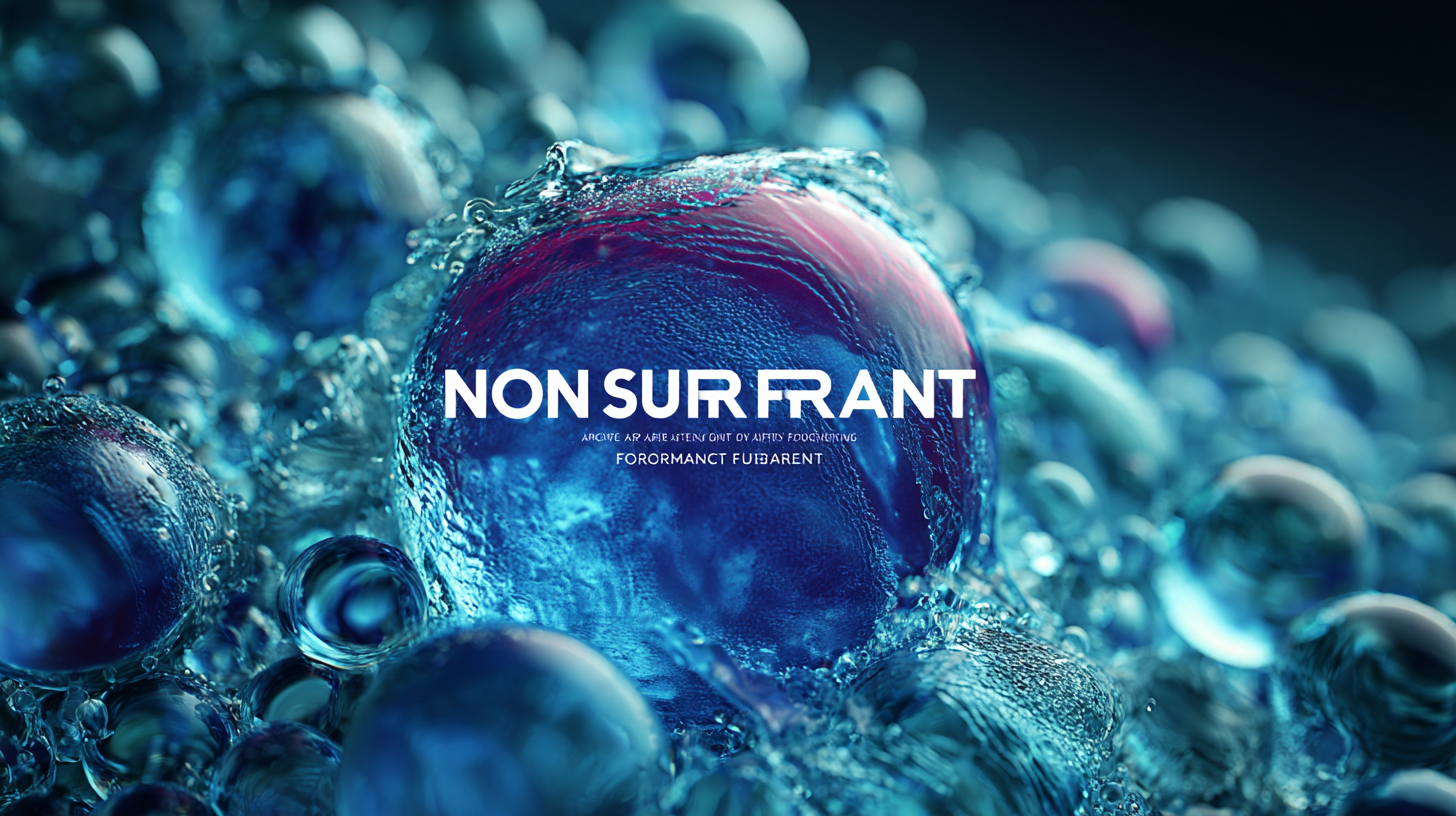
Mastering the Art of Non-Surfactant Formulations: A Comprehensive Guide
In recent years, the demand for Non Surfactant formulations has surged, driven by increasing consumer awareness of sustainable and eco-friendly products. According to a report by MarketsandMarkets, the global green surfactants market is projected to reach $36.94 billion by 2025, highlighting a significant shift towards alternatives that minimize environmental impact. Non Surfactant formulations offer a viable solution by utilizing natural ingredients that reduce surface tension without traditional surfactants, which can be harmful to aquatic life. Industries ranging from personal care to home cleaning products are increasingly adopting these formulations to meet regulatory demands and consumer preferences.

This comprehensive guide aims to explore the art of mastering Non Surfactant formulations, presenting innovative alternatives that align with both market trends and environmental sustainability goals.
Understanding Non-Surfactant Formulations and Their Applications
Non-surfactant formulations are gaining attention in various industries due to their unique properties and applications. Unlike traditional formulations that often rely on surfactants to enhance solubility and stability, non-surfactant formulations utilize alternative materials that can provide similar benefits while minimizing irritation and toxicity. Recent studies highlight the effectiveness of lipid-based formulations, particularly supersaturated systems, in enhancing the delivery of challenging compounds. These lipid-based approaches represent a promising frontier for further industrial applications, showcasing their versatility in optimizing bioavailability.
The potential of non-ionic surfactants also cannot be overlooked, especially in skincare applications. Recent evaluations of non-ionic surfactant-based emulgels indicate their efficacy in creating stable and gentle formulations, ideal for sensitive skin. Furthermore, the incorporation of non-ionic surfactants in controlled drug release systems demonstrates their ability to improve therapeutic outcomes while reducing skin irritation risks. This innovative approach not only enhances the performance of topical applications but also highlights a shift towards safer, more effective formulation strategies without relying on traditional surfactants.

Key Benefits of Formulating Without Surfactants for Skin Care Products
In recent years, the skincare industry has witnessed a significant shift towards surfactant-free formulations, largely due to growing consumer demand for gentler and more natural products. According to a report by Grand View Research, the global natural skincare market is projected to reach $25.11 billion by 2025, highlighting an increasing awareness around the potential irritation caused by traditional surfactants. By formulating without surfactants, brands are not only responding to consumer preferences but also offering safer alternatives that maintain the skin's natural barrier.
One of the most compelling benefits of non-surfactant formulations is their ability to minimize skin irritation. A study published in the Journal of Investigative Dermatology found that surfactants could disrupt the skin barrier, leading to increased trans-epidermal water loss and subsequent skin sensitivity. In contrast, products that prioritize non-surfactant ingredients can enhance hydration and maintain the integrity of the skin’s microbiome, promoting overall skin health. This aligns with the findings from the Kline Group, which indicates that products emphasizing skin barrier protection are seeing an uptick in consumer popularity, reflecting a broader trend towards wellness-driven skincare solutions.
Mastering the Art of Non-Surfactant Formulations: A Comprehensive Guide
| Aspect | Details |
|---|---|
| Benefits of Non-Surfactant Formulations | Gentler on skin, reduced irritation |
| Common Ingredients Used | Natural oils, butters, and plant extracts |
| Target Skin Types | Sensitive, dry, and combination skin |
| Formulation Challenges | Stability and emulsification without surfactants |
| Popular Products | Creams, lotions, and balms |
Comparative Analysis: Non-Surfactant vs. Surfactant-Based Formulations
In the realm of formulation science, the choice between surfactant and non-surfactant systems significantly influences product performance and safety. Surfactants, with their unique ability to reduce surface tension, are widely used in various applications. They enhance solubility, improve spreading, and stabilize emulsions. However, their use can sometimes lead to irritation issues and environmental concerns, prompting formulators to explore alternatives. Non-surfactant formulations, on the other hand, utilize ingredients that achieve similar effects without the drawbacks associated with surfactants, making them an appealing option for sensitive applications.
When comparing non-surfactant and surfactant-based formulations, it is essential to consider performance metrics such as stability, efficacy, and sensory attributes. Non-surfactant formulations may rely on film-forming agents or natural emulsifiers, which can provide enhanced gentle cleansing or moisturizing properties. Furthermore, these formulations often cater to the growing demand for “clean” beauty and environmentally friendly products. As consumers become more aware of ingredient safety and sustainability, mastering non-surfactant formulations not only meets market demands but also offers innovative pathways for developing high-quality products. The comprehensive guide on mastering non-surfactant formulations will navigate these complexities, equipping formulators with the knowledge to make informed choices in their product development endeavors.
Comparative Analysis: Non-Surfactant vs. Surfactant-Based Formulations
Innovative Ingredients to Enhance Non-Surfactant Products
In the evolving landscape of personal care and cosmetic formulations, non-surfactant products are gaining traction for their mildness and efficacy. According to a report by Research and Markets, the global surfactants market was valued at approximately $45 billion in 2020, with a growing interest in alternatives that avoid harsh chemicals. Innovating non-surfactant formulations caters to consumers who demand gentler options that maintain product performance without compromising skin integrity.

Key ingredients are emerging as game-changers in this space. For instance, plant-based emulsifiers and stabilizers, like glyceryl stearate and cetearyl alcohol, not only enhance texture but also improve the skin's barrier function. A recent study published in the Journal of Cosmetic Science noted that formulations utilizing these ingredients showed a 30% increase in skin hydration compared to traditional surfactant-based products. Moreover, advances in biotechnological ingredients, such as fermented extracts and polysaccharides, are being hailed for their efficacy in enhancing skin health while offering sustainable sourcing advantages.
As the demand for non-surfactant products continues to rise, formulators are tasked with diversifying their ingredient portfolios. The incorporation of innovative components such as natural oils, waxes, and botanical extracts allows for the creation of multifunctional products that meet the needs of eco-conscious consumers, who now represent a significant 54% of the market, as reported by Euromonitor International. This shift underscores the potential for growth in the non-surfactant segment, highlighting the importance of adopting advanced formulations to keep pace with consumer preferences.
Practical Tips for Developing Effective Non-Surfactant Formulations
Creating effective non-surfactant formulations can be a daunting task, yet with the right approach, you can master this art. First, it's essential to understand the role of non-surfactants in stabilizing emulsions, enhancing texture, and improving the overall performance of your product. When developing these formulations, consider using natural thickeners like xanthan gum or guar gum, which not only provide viscosity but also improve sensory attributes without the harshness of traditional surfactants.
In addition, the choice of oils is crucial. Opt for lightweight, non-comedogenic oils such as jojoba or squalane, which can help achieve a desirable skin feel without clogging pores. Furthermore, incorporating encapsulated actives can enhance the delivery and efficacy of ingredients, ensuring your formulation is both effective and gentle. Don't forget to test your formulations rigorously; stability studies and user trials can provide invaluable insights into how your product performs under different conditions. By focusing on these practical tips, you can create non-surfactant formulations that not only meet consumer demands but also stand out in a crowded market.
